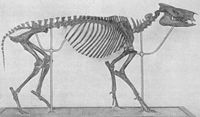| Hyrachyus Temporal range: Eocene | |
|---|---|

| |
| Fossil | |
| Scientific classification | |
| Domain: | Eukaryota |
| Kingdom: | Animalia |
| Phylum: | Chordata |
| Class: | Mammalia |
| Order: | Perissodactyla |
| Superfamily: | Rhinocerotoidea |
| Family: | †Hyrachyidae |
| Genus: | †Hyrachyus Leidy, 1871 |
| Species | |
| |
Hyrachyus (from Hyrax and Ancient Greek: ὗς "pig") is an extinct genus of perissodactyl mammal that lived in Eocene Europe, North America, and Asia. Its remains have also been found in Jamaica. It is closely related to Lophiodon.
Description
The 1.5-m-long beast was related to palaeotheres, and suspected to be the ancestor of modern tapirs and rhinoceroses. Physically, it would have looked very similar to modern tapirs, although it probably lacked the tapir's characteristic proboscis. Its teeth, however, resembled those of a rhinoceros, supporting the idea of its relationship with that group.
 Restoration of H. eximius
Restoration of H. eximius skeleton
skeleton
References
- ^ Savage, RJG & Long, MR (1986). Mammal Evolution: an illustrated guide. New York: Facts on File. p. 191. ISBN 0-8160-1194-X.
- Domning, D. P.; Emry, R. J.; Portell, R. W.; Donovan, S. K.; Schindler, K. S. (December 1997). "Oldest West Indian Land Mammal: Rhinocerotoid Ungulate from the Eocene of Jamaica". Journal of Vertebrate Paleontology. 17 (4). Society of Vertebrate Paleontology: 638–641. Bibcode:1997JVPal..17..638D. doi:10.1080/02724634.1997.10011013. JSTOR 4523853.
- Hayden, F.V. Report of the United States Geological Survey of the Territories, Volume III. (1883)
| Taxon identifiers | |
|---|---|
| Hyrachyus | |
This prehistoric odd-toed ungulate-related article is a stub. You can help Misplaced Pages by expanding it. |








